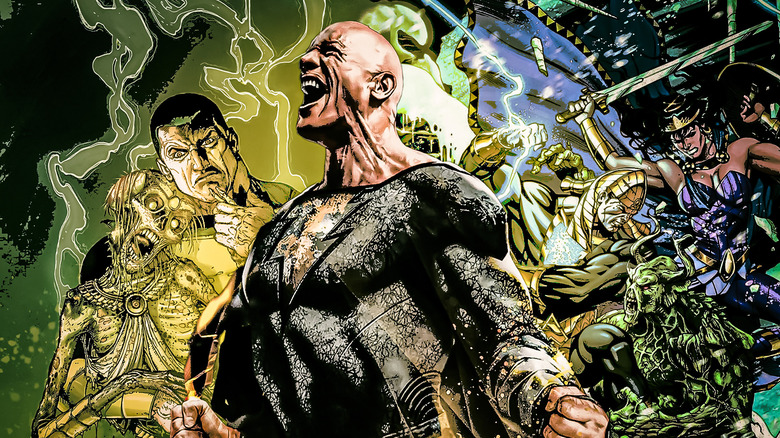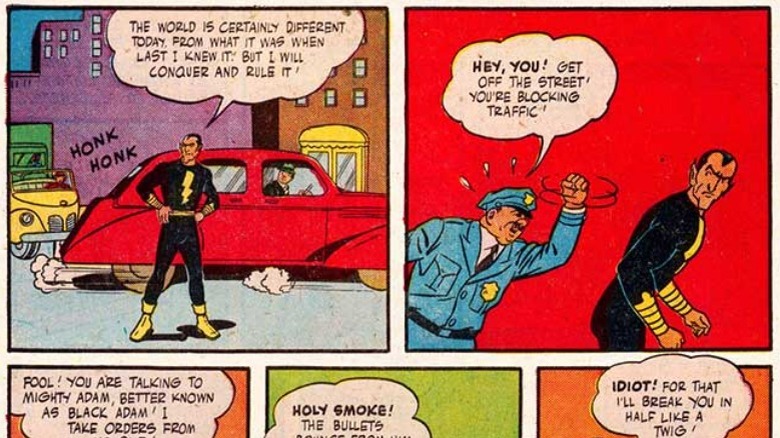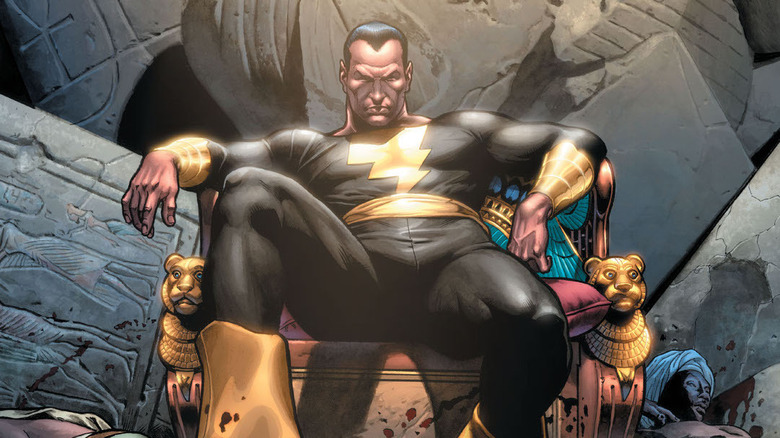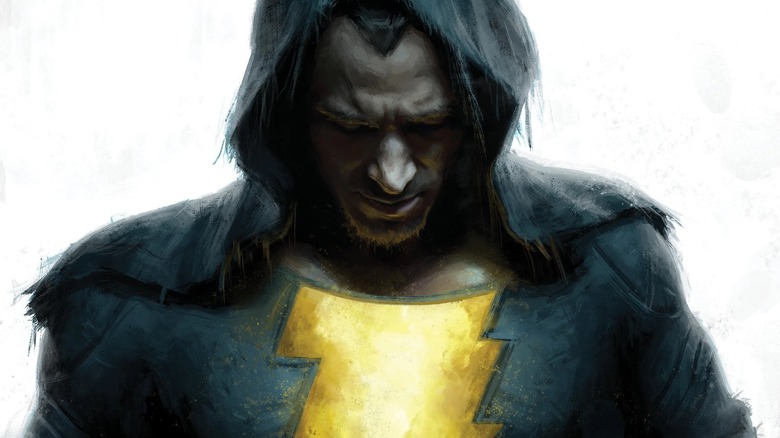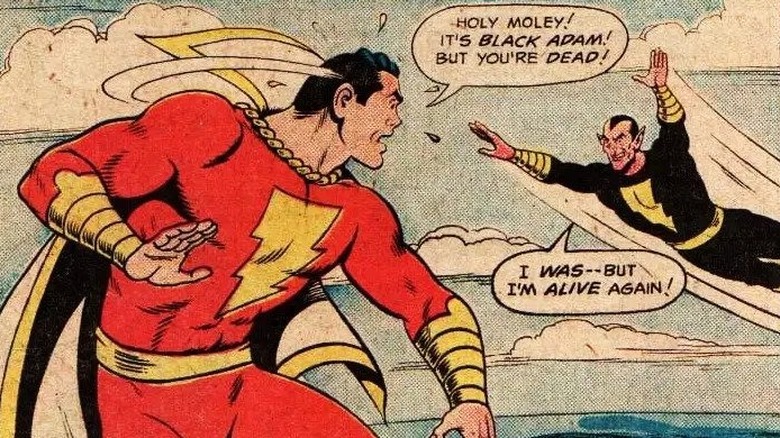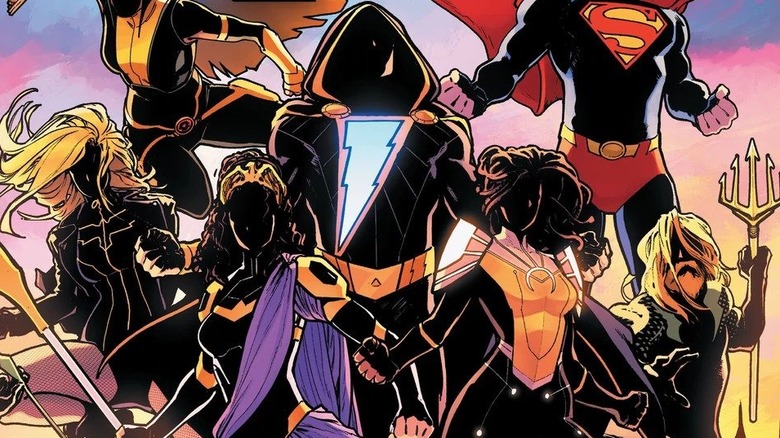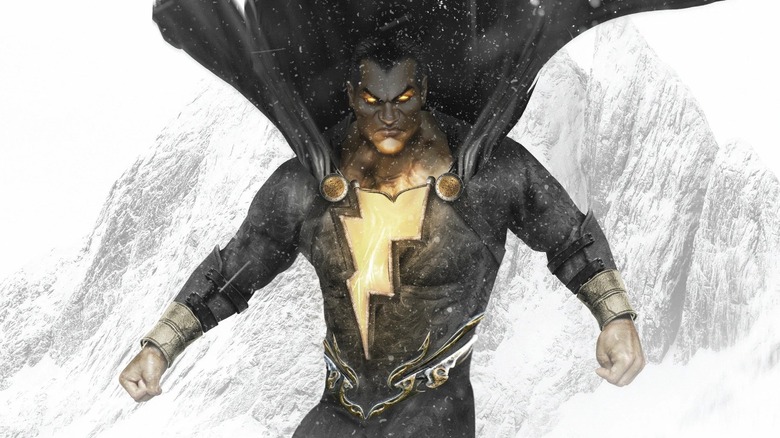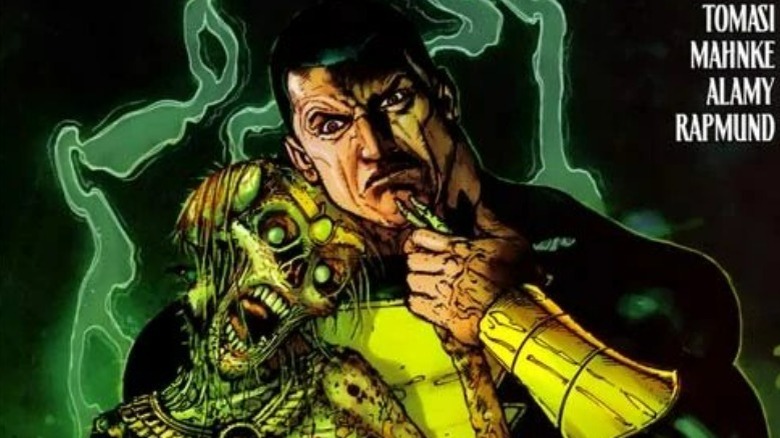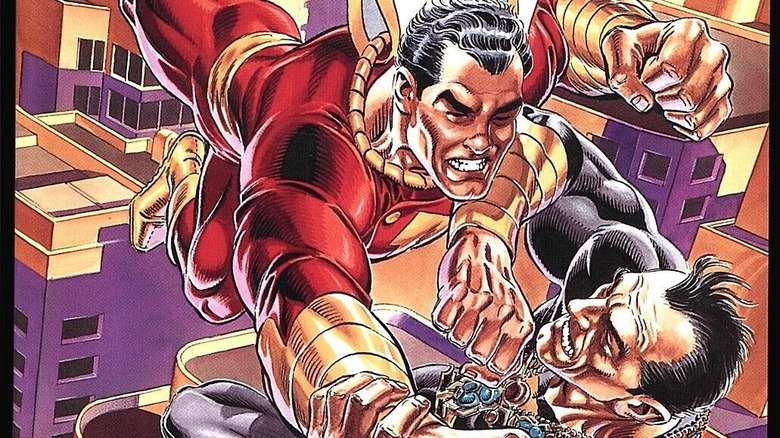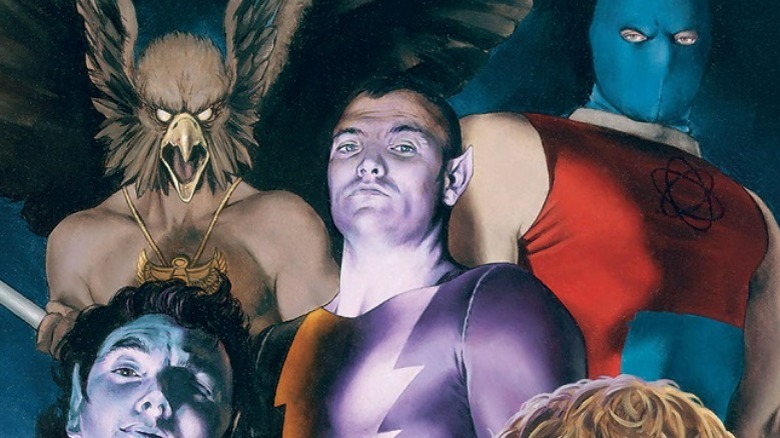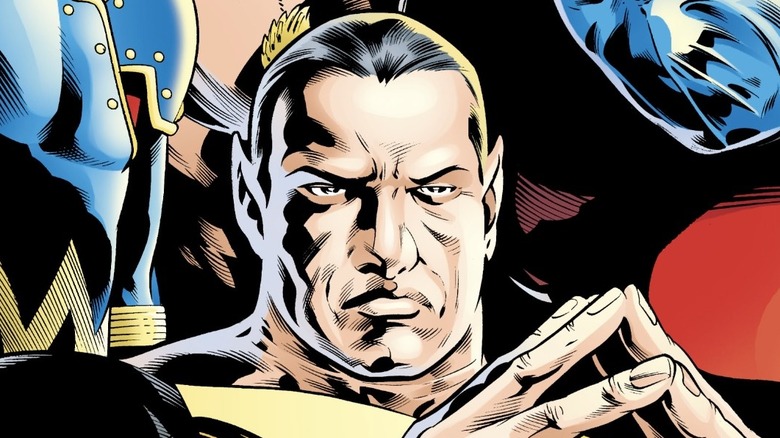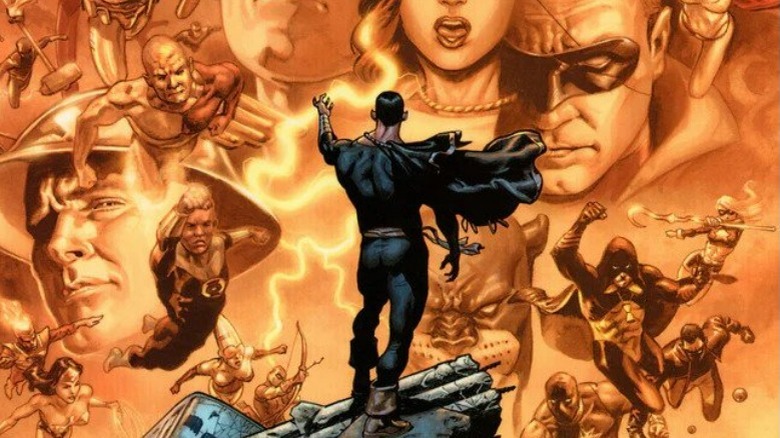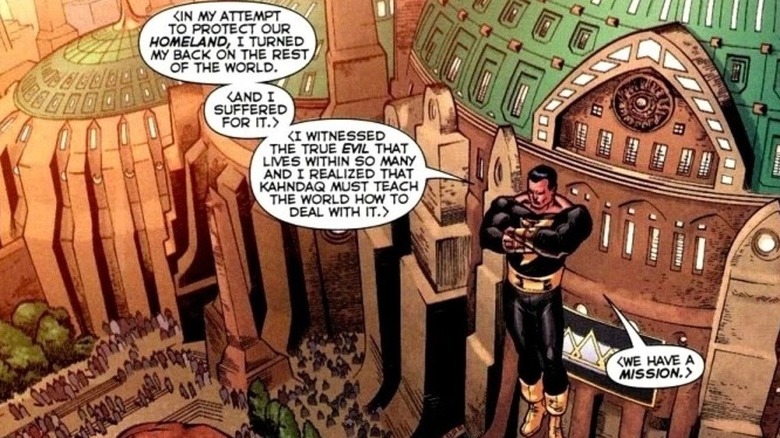The 12 Best Black Adam Comics, Ranked
Black Adam is one of the most powerful characters in DC Comics' vast pantheon. He is the creation of Otto Binder and C.C. Beck, and made his debut in 1945 (however, the series that Black Adam first appeared in, "Marvel Family," was published by Fawcett Comics, and it wasn't until decades later that he'd be licensed and purchased by DC Comics, the complicated story of which is recounted by former DC Comics President Paul Levitz). The character's backstory has been updated and fiddled with over the years, but the elements that have remained pretty consistent are that he is of ancient Egyptian origin who's granted superhuman powers by the wizard Shazam, and while he starts off as a good man, later becomes corrupted.
Like many comic book characters who've been around for ages, Black Adam has evolved and undergone numerous changes throughout. While he is generally portrayed as a villain, he's gone through periods of reform to take on a more heroic persona. While Black Adam spent much of his time in the DC Comics universe as the primary villain to Billy Batson-slash-Captain Marvel-slash-Shazam and the other members of the Marvel Family, he's risen to prominence over the last couple of decades and has even been a member of the Justice League and Justice Society of America. Let's take a look at the comics that have defined Black Adam over the years.
12. Marvel Family #1
This issue opens up with Black Adam suddenly appearing in a busy city to cause some trouble until he's interrupted by Captain Marvel and Captain Marvel Jr., who are surprised by how similarly dressed he is to them. Black Adam disappears, prompting Captain Marvel and Captain Marvel Jr. to revert to their civilian identities as Billy Batson and Freddy Freeman, respectively, and contact the wizened wizard Shazam for answers. Shazam tells them that Black Adam was once a student of his and, believing him to be a good man, he bestowed Black Adam with superpowers. Unfortunately, these new abilities contaminated Black Adam's character, and he developed an unstoppable hunger for power. To stop this from happening, Shazam exiled Black Adam to a distant star, only for him to return to continue his megalomaniacal quest.
For such an old comic book that was intended for young readers, there are some surprisingly dark elements in this issue. For example, when Black Adam first arrives in the city, he's this close to snapping a police officer in half until the Marvel Family arrives to stop him. The ending also sees Black Adam stripped of his powers, only to return to human form and instantly age 5,000 years into a rotten corpse (only for him to return later on, obviously). Still, the comic introduces a lot of elements that continue to typify Black Adam and his relationship with the Marvel Family, so it's worth reading for that alone.
11. 52
"52" was a weekly series that followed the inhabitants of the DC comic book universe in the wake of the events of "Infinite Crisis," wherein Clark Kent, Bruce Wayne, and Diana Prince are no longer operating as Superman, Batman, and Wonder Woman, respectively. Part of the series is dedicated to Black Adam's vendetta against the U.S., prompting him to align himself with other countries in his quest. However, he begins to change his vengeful ways when he meets — and eventually falls in love with — Adrianna Tomaz, who convinces him to use his powers in a more peaceful manner. The two are married and form a Black Marvel Family, with Black Adam seemingly giving up his violent life for good. Of course, that doesn't last long ...
Black Adam has vacillated between good and evil so much that it's become a major part of his character. However, his arc in "52" takes readers on an emotional roller coaster, showing us how genuinely compassionate he can be, while also showing us how destructive he is when pushed too far. We truly care for him as he gradually begins to fall for a woman who inspires him to use his gifts for the benefit of the world. All of the morality that he displays is turned upside down when Tomaz is brutally murdered, prompting him to go on a murderous rampage that includes destroying an entire country, reminding us that the monstrous side of him will never die.
10. Black Adam
In this solo series, Black Adam has been stricken with a rare illness that is now eating away at his immortality. This forces him to confront his nearly countless years spent destroying more than creating, conquering more than saving. Having now reverted to his human form as Teth-Adam, he is on the search for a worthy candidate to take on his role, including his powers, in an attempt to make up for terrible acts he's committed throughout his long life. He believes that a young man, medical student Malik White, might be the one to do that. White also happens to be a descendent of Black Adam, but that may not be enough to qualify him for the powers of Shazam.
After Warner Bros. released the (not so good) big-budget "Black Adam" movie, it made sense for DC Comics to give the character a new solo comic book series to capitalize on his new mainstream fame. However, what could have been a cynical cash grab is actually a legendary run in the making. In the capable hands of legendary comic book writer Christopher Priest, Black Adam is given another level of complexity rarely seen before, simultaneously recognizing his roots while also pushing him into novel emotional territory. The action is just as hard-hitting as you would hope from a "Black Adam" comic, but it's bolstered by a thought-provoking narrative that elevates the character to new heights.
9. Shazam! #28
Doctor Sivana has cooked up another mad scheme to bring down his nemesis, Captain Marvel. He resurrects Black Adam with his Reincarnation Machine to kill the old wizard Shazam as this will, Sivana believes, result in both Black Adam and Captain Marvel's deaths, as well. Upon Black Adam's return, he immediately sets out after Captain Marvel for a rematch in Boston, nearly destroying American artifacts and monuments in the ensuing battle. However, their fight continues across time as they're both sent to 1773, with Black Adam tricking Captain Marvel into reverting to Billy Batson. Good thing Paul Revere is around to lend Billy a helping patriotic hand. Meanwhile, Black Adam has an old score to settle with Uncle Dudley.
As you can tell, this is a pretty wacky story that's quite typical of the more lighthearted superhero comics of the 1970s. Still, it's got a delightful charm that makes it extremely readable even today and is worth adding to any "Black Adam" fan's collection. Also, this issue has the unique distinction of not only seeing the return of Black Adam (he died in his very first appearance in 1945's "Marvel Family #1") but for introducing him into the DC Comics universe as they had purchased the rights to all of Fawcett Comics' characters in 1972. From here on out, Black Adam would gradually be developed into one of their most powerful characters.
8. Justice League: Prisms
Superman has taken the lead in revamping the Justice League, whose lineup consists of old stalwarts like Batman, Aquaman, and the Flash, as well as new additions like Hawkgirl, Hippolyta, and Naomi. They're going to have their work cut out for them on their first mission together, taking on a massive and mysterious enemy who caused considerable destruction in Kahndaq. Black Adam, of course, isn't happy about the unprovoked attack on his country and sets out to find the assailant. Things get complicated when he traces its energy signature to Naomi's home dimension, which means that Black Adam intends to have some words with the young superheroine.
Writer Brian Michael Bendis has been doing some great work since he moved from Marvel Comics to DC Comics, and his inaugural storyline for the Justice League continues his winning streak. While this arc (which runs through issues #59-63) is noticeably lighter in tone than previously seen in the recent "Justice League" series, there's no shortage of thrilling twists and turns. We see a more heroic side of Black Adam here, who becomes one of the team's newest additions. His overly intense and stoic nature makes him stand out from the rest of the Justice League members, but Bendis has a lot of fun contrasting his personality with his teammates.
7. Black Adam: Endless Winter
"Endless Winter" is a crossover event that follows DC's strongest heroes taking on the Frost King, an ancient metahuman with ice-based powers who's on a destructive quest to reunite with his family. It's revealed that Black Adam — along with Swamp Thing, Hippolyta, and the Viking Prince — had actually teamed up to bring down the Frost King in the 10th century. In the present, they must team up with the Justice League to battle the Frost King, who's even more powerful than before. With his country Khandaq freezing over with the rest of the world, Black Adam must prove that he's more than just a powerful being who can protect his people.
Up until this point, with the exception of a few stints with the Justice Society of America, Black Adam was always a pretty reluctant antihero at best and a ruthless villain at worst. However, this issue and his role in the main story showed a remarkable change in his character, which is handled brilliantly. Black Adam acts in a way that's almost as cold as his frosty enemies, but there are moments of honor that peek through his brutal exterior, hinting at the heroic turn he's about to make, which would take place in "Justice League: Prisms."
6. Black Adam: The Dark Age
Following the events of "World War III," which ended with Black Adam being stripped of his powers, he recruits a team of followers who help disguise him so that he can sneak into Kahndaq to steal Isis' remains. He's mostly successful (he accidentally leaves behind her finger and ring in the fight), and makes his way to a Lazarus Pit as part of a plan to bring her back to life. However, he discovers that resurrecting her isn't possible without her missing finger or her magical amulet, prompting Black Adam to turn to Felix Faust for help. The evil wizard makes a deal with him: In exchange for helping Black Adam find the amulet and restore some of his power, he will arrange for the returned Isis to free him from his prison.
"Black Adam: The Dark Age" opens with the worst state Black Adam could possibly be in, which means, narratively, it's the best state for a character like him from which to evolve. With powers taken away, family killed, and home country in ruins, most other characters would've called it quits. However, this is Black Adam, a man with a will so tough that he's ready to get into a fistfight with reality itself to prove his greatness, and he does so in this story with flying colors. It's a brutal and violent tale, but one that flawlessly illustrates why you shouldn't piss off Black Adam, even when he's a regular human being.
5. The Power of Shazam!
In this retelling of Captain Marvel and Black Adam's origins, the young Billy Batson's parents are murdered by their colleague Theo Adam during an archeological dig in Egypt, and Theo even kidnaps their daughter Mary. This leaves Billy without a family of his own. However, he soon meets the wizard Shazam, who grants him his powers and the ability to turn into Captain Marvel with but a magic word. Billy enters his new form as Captain Marvel and sets out after Theo Adam, who he discovers is the reincarnation of Teth-Adam. Adam, the original host of Shazam's powers, is on the hunt for an ancient scarab that will allow him to become Black Adam.
This version of the Captain Marvel and Black Adam mythology manages to update the characters for the modern age while maintaining a charming nostalgic touch. Black Adam's portrayal is delightfully nasty here, and while it doesn't feature the sort of complexity that would typify him in later storylines, it does harken back to a classic era of mustache-twirling villains who stop at nothing to get what they want. This is even reflected in the artwork, as Black Adam's look is reminiscent of the Universal Monsters icon, Boris Karloff.
4. JSA: Black Reign
Asim Muhunnad is the corrupt ruler of Kahndaq, but only until Black Adam has something to say about it. The Man in Black has recruited a group of other superpowered humans to help him lead a rebellion in his home country. Atom Smasher is uneasy about the violent coup he's signed up for but changes his mind when Black Adam shows him a warehouse that belonged to Muhunnad that's filled with child slaves. It seems that Black Adam's only motive is to restore peace to his motherland, but the brutal methods employed by him and his Black Reign revolution don't sit well with his fellow members of the Justice Society of America.
"Black Reign" is one of the more action-packed stories on this list. Black Adam and his crew don't pull their punches when they take back Kahndaq from Asim Muhunnad, but the real brutality occurs when Black Adam takes on the JSA. However, despite the violence of the story, it also is a thrilling look at Black Adam's turn from a reluctant hero to an authoritarian villain. His loyalty to his people is understandable, and in some ways admirable, but he's not the sort of hero to use a cool head to rescue those he cares about, becoming the epitome of "might equals right."
3. JSA: Savage Times
Ever since Black Adam joined the Justice Society of America, Captain Marvel has been suspicious of him, always operating under the impression that he was still evil, despite his decision to fight on the side of the angels. However, Captain Marvel gets to see a different side of Black Adam when he, along with Mister Terrific and Hawkgirl, end up in ancient Egypt and must square off against the immortal villain Vandal Savage. Of course, in order to take him down, they must team up with the heroes who were alive back then, including Prince Khufu, Chay-Ara, and the younger Black Adam, Teth-Adam, who is far more heroic than his present-day counterpart.
"Savage Times" is one of the first stories to shed some light on Black Adam's early days as a good guy, giving us a fascinating contrast between his past and future selves. Time travel is a fun yet cliché plot device in superhero comics, but it's used to great effect here. Not only does "Savage Times" deliver an enjoyable story wherein our modern heroes bump into the heroes of history, but it also gives a deeper look into one of DC's oldest and most complex characters. A standout scene is when Captain Marvel, upon returning to the present, has a meaningful exchange with Black Adam after his encounter with Teth-Adam.
2. World War III
Following the death of his family after trying to live a peaceful life, Black Adam goes on a rampage against the entire world. Black Adam's frenzy results in massive amounts of damage and death around the globe, and it will take nothing short of the might of Earth's strongest heroes coming together to put an end to his infinite rage. But that proves to be insufficient as reinforcements are called in, including Firestorm, who's been in retirement, and Supergirl, who arrives from the 31st century to lend a hand. With Batman, Wonder Woman, and Superman gone, and many other heroes occupied with tending to the chaos caused by Black Adam's tempest, it's ultimately up to Captain Marvel and a few others to use their guile to stop him.
"World War III" is a dark look at just how dangerous a Black Adam can be when he's angry. There's no shortage of action on tap, and scenes of destruction put the story closer to a Michael Bay or Roland Emmerich movie. However, it's not just the violence and explosions that make this narrative so good; it's also a deep look into the motivations of Black Adam. As terrible as his actions are in "World War III," we're always reminded that he's brought down to that level after his chance at becoming a good person is cruelly stripped from him.
1. JSA: Black Vengeance
Following on from the events of "Black Reign," Atom Smasher's fate with the Justice Society of America is uncertain, as the other members debate whether his actions in Kahndaq should disqualify him from being on the team. But before they can vote, Black Adam recruits Atom Smasher to accompany him to Kahndaq, which is under attack from the Spectre, who's on a mission to rid the planet of magic. The JSA arrives to help the citizens of Kahndaq, but Black Adam warns his people not to trust them. However, as Black Adam and the JSA struggle to put a stop to the Spectre's wrath on Kahndaq, it falls on Atom Smasher to make the ultimate sacrifice.
This is not only one of the best stories in Geoff Johns' run on "JSA," it's quite possibly the best Black Adam story ever. Here, the full range of his incredibly layered character is on full display. His loyalty to his people urges him to go to great lengths to protect them when they are under attack, but his arrogance prevents him from accepting the help of those who are best equipped to handle this sort of conflict. He shows no reluctance in using brutal methods in his fight but is not afraid to help those who've helped him in the past. "Black Vengeance" is a testament to how to make a character complicated without any of their many facets undermining each other.
